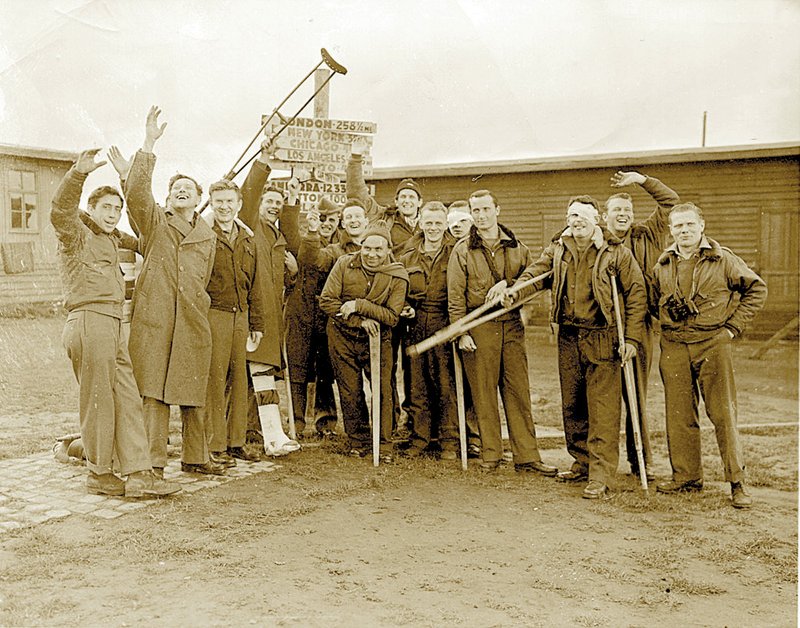NEW ORLEANS — A violin made from bed slats, a bomber jacket and journals filled with humor, nostalgia, sorrow and boredom help to tell the stories of the 92,820 Allied soldiers held in nearly 100 Nazi prisoner of war camps.
“Guests of the Third Reich,” an exhibit which opened on Veterans Day at the National World War II Museum, is about those “Kriegies,” as they called themselves - short for “Kriegsgefangener,” German for “prisoner of war.”
Items on display through July 7 are among those to be shown in the Liberation Pavilion planned for completion in 2016. That pavilion will also have a section about POWs held in brutal Japanese POW camps where more than 40 percent of the 27,465 Americans captured in the Pacific died. But of 93,941 who surrendered to Germany, 92,820 survived.
Japan had not ratified the Geneva Conventions for humane treatment of POWs. Germany had, and generally followed its requirements.
Not always. One part of the exhibit is about POWs who were sent to concentration camps or executed. Those in the concentration camps included 350 Americans sent from Stalag IXB to the slave labor camp in Berga because they were or “looked” Jewish, and 168 Allied airmen sent to nearby Buchenwald. Another 362 American POWS and more than 100 Belgians were killed in groups, including 84 shot in the “Malmedy Massacre,” a mass killing first reported by Associated Press war correspondent Hal Boyle.
The exhibit is divided in five sections: Capture, Camp Life, Liberation, Global Conflict - which includes the “War Crimes” area - and After the Camps.
Camp Life includes seven “wartime logs” - diaries provided by the YMCA to be sent in Red Cross packages for POWs. Their contents have been scanned and put on iPads so visitors can page through them.
“There’s probably about 700 pages in all if you read all of them,” said curator Kimberly Guise.
Some of the diaries’ contents also are on the website set up for the exhibit.
Early American POWs were airmen, who hit the ground at a rate of about 400 a month in 1943. Then came the Battle of the Bulge, when nearly 23,000 Americans, most of them infantry, were captured in December 1944.
Most of the logs include drawings of burning aircraft or memorials to dead crewmen, Guise said.
The men also described lighter moments.
“There are a number of ways we spend our spare time. As I sit here writing this, there are two across from me studying French, some are playing cards, others are reading books, the rest have the two guitars, anything to keep your mind occupied and not think of home,” wrote Bruce L. Worrell, captured in Italy in May 1944 during service with the 85th Infantry Division’s 359th Infantry Regiment and held at Stalag IIB.
Guise said, “There were whole colleges that were set up. They called them barbed wire universities.”
The diaries, each printed with the title “A Wartime Log,” also include home addresses of men in the camp, cartoons, drawings of other POWs - sometimes with comments by other soldiers and airmen - maps, photographs from home, and lovingly detailed drawings of U.S. bombers and of pinup girls, sometimes together.
There also are programs and even photographs of plays put on by POWs, collections of cigarettes and of military patches, and a lot of verse. There are song parodies and also verses clipped from magazines and newspapers. Some may have been written by the POW; others are written from memory.Some were copied and recopied from log to log.
Guise said she was struck by a parody of “Thanks for the Memories” that showed up in several logs.
“It sounds unbelievable - something that would be in Hogan’s Heroes or a comedy film,” she said.
The flight jacket was worn by Paul Hayslip, the only crewman on the B-26 bomber “Ramblin’ Wreck” who was able to parachute to safety before it crashed. A photograph shows him and his crew at Louisiana’s Barksdale Field, now Barksdale Air Force Base in Bossier City, La.
The violin’s neck was whittled from a chair leg by Clair Cline, an Army Air Corps pilot captured in Holland and held in Stalag I after his B-24 was shot down in February 1944. He and others scraped glue from chairs to hold it together.
“It traveled the country in 1946 as part of an exhibition of POW life,” Guise said. She said Cline’s son, grandson and granddaughter, all professional string players, offered it while she was planning the exhibit.Cline himself was a carpenter after the war, she said.
“Guests of the Third Reich”: Through July 7, 2013, at the National World War II Museum, 945 Magazine St., New Orleans; nationalww2museum.org or (504) 528-1944. Adults, $21, senior citizens, $18, children 5-12, $12. Open daily 9 a.m.-5 p.m.
Travel, Pages 50 on 12/02/2012

